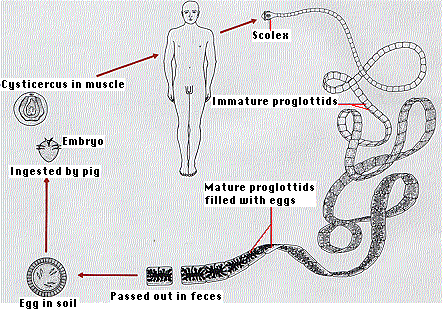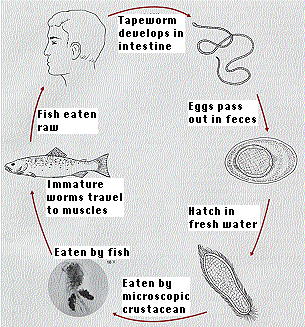 The pig tapeworm parasitizes two hosts:
The pig tapeworm parasitizes two hosts:
- the definitive host (containing the adult, sexually-reproducing stage), the human
- an alternate host, the pig.
The life cycle:
- Pigs raised in unsanitary conditions (access to human feces) may contain cysticerci "bladder worms" embedded in their muscles (meat).
- These consist of a capsule containing a scolex.
- When a bladder worm is ingested (e.g., in a pork chop), the gastric juice of the stomach dissolves the wall of the capsule.
- The scolex turns inside out and attaches by suckers and hooks to the wall of the intestine.
- It then begins to produce buds, called proglottids, at its posterior.
- These remain attached to each other for a time and, as they mature, each develops both male and female sex organs.
- The most mature proglottids eventually break loose and are passed out in the feces.
- Before this happens, the chain may reach a length of 20 feet (6 meters) and contain over 1000 proglottids.
- Each proglottid may contain up to 60,000 eggs.
- Although there are rudimentary nervous, excretory, and muscular structures shared by the proglottids, each can be considered a separate sexually-reproducing individual.
- Fertilized eggs released by the shed proglottids may reach the soil ready to be consumed by a pig.
If tapeworm eggs should be ingested by a human instead of a pig (not all that uncommon in regions with poor sanitation), cysticerci can still develop. These may form large cysts — often in the brain — which can be life-threatening (far more so than a 20-foot tapeworm in your intestine).
 This is the largest (up to 18 m = 60 feet!) tapeworm found in humans.
It requires three hosts in order to complete its life cycle:
This is the largest (up to 18 m = 60 feet!) tapeworm found in humans.
It requires three hosts in order to complete its life cycle:
- a microscopic freshwater crustacean, Cyclops
- a fish (that eats Cyclops)
- a human (that eats raw or undercooked fish, e.g., sushi)
A single worm may discharge up to one million fertilized eggs into its host's feces each day.
Historically, human infection has been most common in countries along the Baltic Coast and in the Great Lakes region. But the growing popularity of sushi and sashimi made of raw Pacific salmon has caused infections by the fish tapeworm to become more common throughout the U.S.
9 May 2011
 The pig tapeworm parasitizes two hosts:
The pig tapeworm parasitizes two hosts:
 This is the largest (up to 18 m = 60 feet!) tapeworm found in humans.
It requires three hosts in order to complete its life cycle:
This is the largest (up to 18 m = 60 feet!) tapeworm found in humans.
It requires three hosts in order to complete its life cycle: